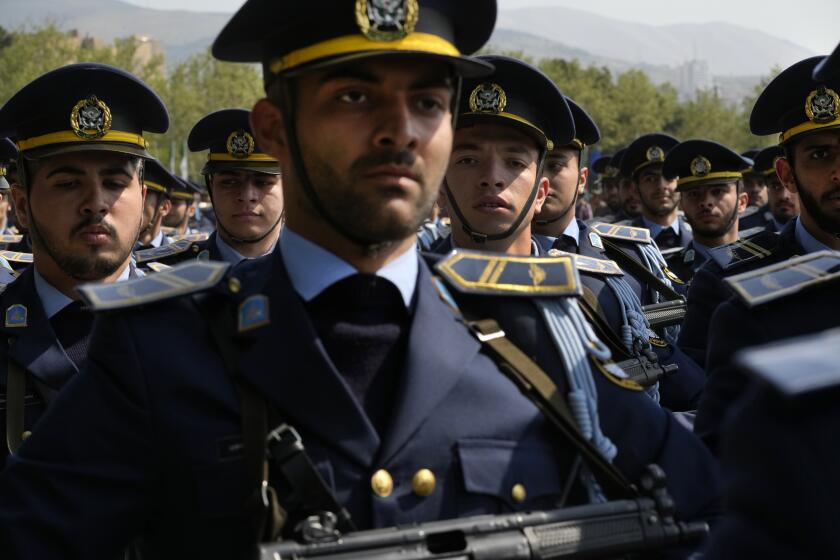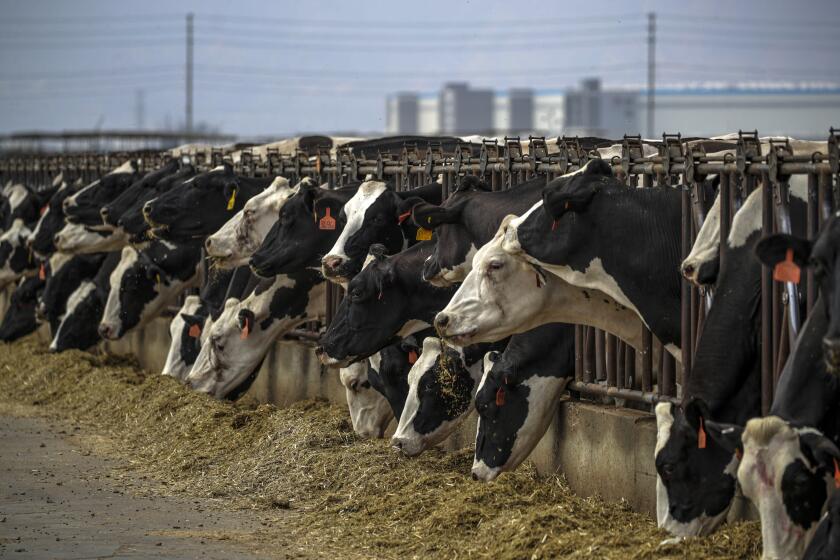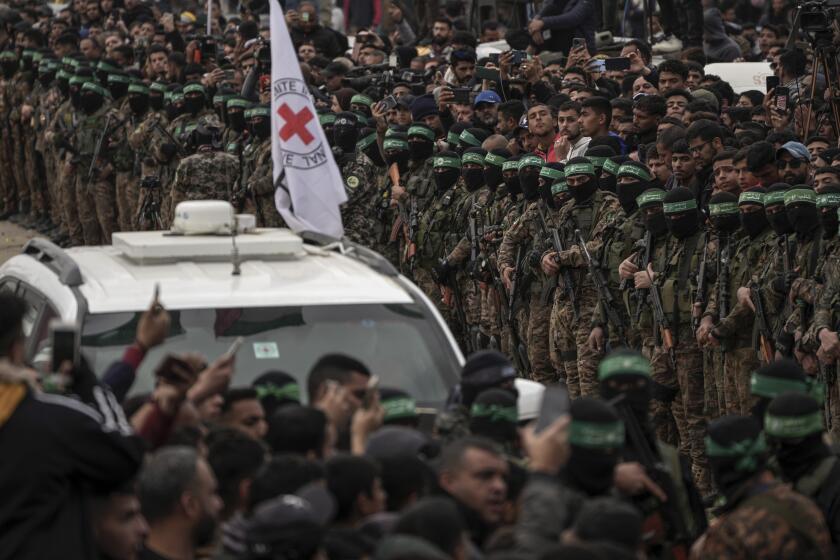
- Share via
SAYEDA ZAINAB, Syria — In the shadow of the gold-domed Sayeda Zainab shrine, six miles south of Damascus, lie the abandoned remains of what was once the de facto headquarters of Iran’s “axis of resistance,” an informal alliance of militant groups created to counter American and Israeli influence in the Middle East.
Defending this shrine — where Shiites believe the prophet Muhammad’s granddaughter is interred — served as a rallying cry for Shiites throughout the region to support former Syrian President Bashar Assad against Sunni insurgents. Tens of thousands of mostly Shiite militiamen — from Syria, Lebanon, Iraq, Yemen and as far away as Pakistan and Afghanistan — flocked to Sayeda Zainab’s run-down neighborhoods, transforming a pilgrimage site into a military zone.
“This place became the political capital for all of these groups,” said Mohammad Al-Hahi, 68, a Sayeda Zainab resident. “They flew in from all over the world and assembled here. Then they would deploy to fight across Syria.”
It all came to an abrupt end last month after Syria’s Sunni rebels toppled Assad, triggering a frantic exodus from the city by anyone who had been fighting under Iran’s banner.


In the weeks since, residents here have begun to grapple with the legacy of their past life under the control of the Iran-backed militias — and what it means for the future of the axis.
Khaled Darwish, 42, who operates a cellphone shop two streets down from the shrine, viewed the presence of so many Shiite-dominated factions as an Iran-led occupation of Sayeda Zainab. They blocked streets and passageways with concrete barriers and stern-looking militiamen.
“You couldn’t go anywhere without one of those groups bugging you, all in the name of supposedly protecting you,” Darwish said. “Whoever carried a weapon acted like they were God. This town wasn’t for us, we who were born and raised here, but for them.”
A seven-minute drive to the nearest town, he added, became an hourlong odyssey of checkpoints manned mostly by foreigners and their local Syrian allies.
Here’s a look at the so-called Axis of Resistance, an Iran-backed coalition including Hezbollah, Hamas and other militant groups devoted to destroying Israel.
Jamal Awadh, a soft-spoken 60-year-old who serves as an administrator in the shrine, said many residents feared what might happen when control of the town passed from Shiite militiamen to Sunni rebels last month.
“As minorities, the old government told us it was protecting us, that if we didn’t join them, the rebels would slaughter us all with knives,” Awadh said.

But so far, he said, Syria’s new overseers have been unfailingly polite, announcing soon after their arrival on the mosque loudspeaker that residents could come visit the tomb without harassment. They even provided transportation for Shiites displaced from Syria’s north to return to their villages.
“They told us: You’re Syrians and you have all your rights,” he said. “They show they care about the shrine just as much as we do.”
For Al-Hahi, the militias’ disintegration meant being able for the first time in years to access a former hotel he owns that had been seized in 2012 by the commander of an Iran-backed Syrian militia, the Abu Fadl al Abbas Brigade.
When Al-Hahi’s brothers pleaded to take back control of the building, the commander threatened to shoot them, Al-Hahi said.
“Their commander kicked everyone out, sold the hotel’s furniture, and made it into their headquarters,” Al-Hahi said, adding that he had never received compensation.
Loved ones are now searching for the estimated 150,000 people who were detained and disappeared in Bashar Assad’s Syrian government gulags.
Al-Hahi has his building back, but now he’s having to contend with crates of weapons and ammunition left in the basement after militiamen fled. Fearful of looters, he welded the basement doors shut and asked residents to watch for anyone entering the premises.
Other signs of the militias’ presence abound. Lampposts are adorned with pictures — many now defaced — of Sayed Hassan Nasrallah, the head of the Iran-backed Lebanese paramilitary faction Hezbollah, who was assassinated by Israel last year. Trucks equipped with cannons and .50-caliber machine guns sit as bereft sentinels on street corners.

A few blocks away from the shrine, behind a high fence and a heavy metal gate, stands a six-story residential building turned into the barracks of the Fatemiyoun, a faction composed of Afghan Shiites. Abu Anwar, a 30-year-old official with the new government, came with a team of rebels to inspect the site for materiel.
One floor revealed the remains of a gym and a library with religious books and pamphlets, along with posters for Fatemiyoun cadres killed in battle. Another had sleeping quarters along with discarded uniforms and a ceremonial banner with the Fatemiyoun’s green-and-yellow logo. Down a corner on the ground floor was a shaft descending more than 30 feet underground that opened up into a cavern presumably used as a depot.
“We’ve found so many places like this in this neighborhood, with tunnels that link up to different buildings,” Abu Anwar said. “Every place that wasn’t a shop, they turned into a headquarters for one faction or another.”
Killings, including a notorious massacre, in a Syrian suburb left residents wanting revenge. Then they heard a militia leader was going to be hanged.
Iran’s ouster both from the town and Syria caps a difficult year for Tehran and the axis, which has suffered multiple setbacks since the Gaza militant group Hamas — an axis member — attacked southern Israel on Oct. 7, 2023, triggering the ongoing Israeli military response.
Hamas has since lost much of its fighting capability, as has Hezbollah, the Lebanon militant and political group that attacked northern Israel after Oct. 7 in a gesture of support for Hamas. Hezbollah was seen as the strongest of the Iran-backed factions, but over the last year, Israel decimated its leadership and wiped out substantial portions of its arsenal.

Losing Syria, the only other nation-state in the axis other than Iran, may be the coup de grace. Though Assad — a member of a Shiite-related sect — did not share his allies’ religious fervor, Syria became the axis’ proving ground, with dozens of Shiite factions fighting alongside his beleaguered forces even as Tehran spent tens of billions of dollars to prop up Assad’s economy. More significantly, Assad allowed Tehran to use Syrian territory as a supply line to Hezbollah and to deploy other militias in regional conflicts against Israel and the United States.
Iranian leaders have sought to downplay the impact of Assad’s defeat. In a lengthy speech last month, Iran’s Supreme Leader Ayatollah Ali Khamenei accused the U.S. and Israel of being behind Assad’s fall, but insisted the axis was not weakened.
“The more pressure you bring on it, the stronger it will become,” he said. “The more you fight them, the more widespread it will become.”
Special correspondent Ramin Mostaghim in Tehran contributed to this report.
More to Read
Sign up for Essential California
The most important California stories and recommendations in your inbox every morning.
You may occasionally receive promotional content from the Los Angeles Times.














